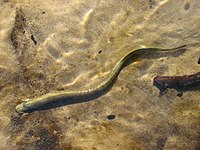
Photo from wikipedia
Microplastics were extracted from freshwater sport fish stomachs containing substantial biomass and identified using optical microscopy, scanning electron microscopy plus energy-dispersive X-ray spectroscopy (SEM/EDS), and Fourier transform infrared (FTIR) micro-spectroscopy… Click to show full abstract
Microplastics were extracted from freshwater sport fish stomachs containing substantial biomass and identified using optical microscopy, scanning electron microscopy plus energy-dispersive X-ray spectroscopy (SEM/EDS), and Fourier transform infrared (FTIR) micro-spectroscopy with automated spectral mapping. An extraction method is presented that uses a negatively pressurized sieve stack and purified water to preserve plastic surface characteristics and any adsorbed persistent organic pollutants (POPs). This nondestructive extraction method for large predators' stomachs enables multiple trophic-level studies from one fish sampling event and provides other dietary and behavioral data. FTIR-identified microplastics 50-1500 μm, including polyethylene (two with plastic additive POPs), styrene acrylonitrile, polystyrene, and nylon and polyethylene terephthalate fibers 10-50 μm wide. SEM/EDS revealed characteristic surface weathering on the plastic surfaces. The nylon fibers appear to be from human fishing activities, suggesting options for management. Some particles visually identified as potential plastics were revealed by micro-spectroscopy to be mineralized, natural polyamide proteins, or nonplastic shell pieces. A low-cost, reflective sample preparation method with stable particle mounting was developed to enable automated mapping, improved FTIR throughput, and lower detection size limit. This study yielded 37 intact prey items set aside for future analyses.
Journal Title: Environmental science & technology
Year Published: 2019
Link to full text (if available)
Share on Social Media: Sign Up to like & get
recommendations!